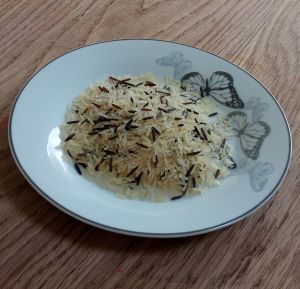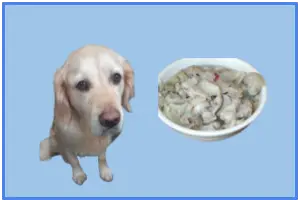
Wild rice is a strange and wonderful food.
Did you know that wild rice is the official state grain of Minnesota?
And did you know that wild rice can be popped just like popcorn?
Just heat it up in a little oil and it’ll start to pop!
Many dog owners may be wondering if wild rice is good to feed to their dog.
Maybe you’ve cooked too much and want to give the leftovers to your dog, or maybe you’ve heard the health benefits of eating wild rice for humans and wonder if the same applies to dogs.
You may be looking for an alternative or supplement to your dog’s diet of regular dog food and are unsure if wild rice is safe.
Whatever reason you may be wondering whether or not wild rice is safe for your dog to eat, we’ve got you covered.
In the information we’ve outlined in this article, we’ll be answering any questions you may have on this subject.
Keep reading to get all the answers you need to your questions about feeding wild rice to your dog.
What is Wild Rice?
So, to address the main point of the article, yes, dogs can eat wild rice. In fact, it’s a healthy food option for them.
But what actually is wild rice?
Most people have no idea that wild rice is not actually a type of rice at all. It is actually the seed of a semi-aquatic grass that has an edible grain.
Wild rice is also native to North America and grows all across waterways and in paddy fields in the United States. The two largest producers are California and Minnesota.
Compared to other strains of rice, like white and brown rice, wild rice has longer grains, firmer texture, and a nuttier and earthier flavor.
Wild rice is a grass-grain hybrid that is highly nutritious and is associated with a plethora of health benefits.
How much nutrition you can get out of wild rice depends entirely on whether it’s cooked or raw. Serving size also contributes to nutrient content.
The following nutrition information is based on a 3.5 ounce serving of cooked wild rice:
- Calories: 101
- Fat: 0.3 g
- Sodium: 3 mg
- Carbs: 21.3 g
- Fiber: 1.8 g
- Sugar: 0.73 g
- Protein: 4 g
As you can see, a single serving of cooked wild rice contains a lot of nutrients, while having basically none of the bad things that other kinds of rice might have in them.
What Is the Difference Between Wild Rice and White Rice?
Besides the length of the grain, there are a few key differences between white rice and wild rice.
The main difference between the two is that wild rice is more nutritious, containing more protein, zinc, and potassium than white rice.
What’s more, wild rice is not actually a rice at all, as we said earlier.
Wild rice is actually a grass, or more specifically, the seed of a grass.
When cooked, wild rice has similar consistency to regular rice, which is probably why people started calling it rice when it’s actually a seed.
Wild rice also has a ton more fiber than white rice since it’s a whole grain.
For reference, one cup of cooked white rice has 0.6 grams of fiber, while a cup of cooked wild rice has over 3 grams.
What Is the Difference Between Wild Rice and Brown Rice?
The differences between brown rice and wild rice are similar to those between white rice and wild rice.
Wild rice belongs to a genus of grains called Zizania, including both variations Zizania aquatica and Zizania taxana.
Brown rice on the other hand belongs to the genus Oryza, which isn’t even in the same family.
Both of these grains grow in the United States, however wild rice is often more difficult to cultivate and harvest, making it more expensive than brown rice.
Even though brown rice and wild rice contain the same amount of fiber, wild rice has much lower caloric and carbohydrate content.
While wild rice may be more nutritious in some areas than brown rice, brown rice has an advantage over its wild cousin in two areas. These are manganese and selenium, both of which brown rice has much more of.
What Is the Difference in Nutrition Between Wild Rice, Brown Rice, and White Rice?
As you can probably tell by now, these three different types of rice do not contain the same levels of nutrition.
White rice is decidedly the least nutritious of the three, with higher carb content and calories than the other two variations.
Brown rice comes in second when it comes to nutrition, having only two distinct nutrition advantages over wild rice, as we discussed earlier.
These being manganese and selenium. It also has the exact same fiber content as wild rice, while white rice has much less.
Wild rice comes in as the most nutritious type of rice in the bunch, packed full of fiber, protein, and nutrients like zinc and potassium.
If you’re looking for the healthiest kind of rice to feed your dog, wild rice is the right option to choose. It even has less fat content and carbs, making it good for low calory meals.
What Is the Best Way to Prepare Wild Rice for Dogs?
Rice is one of the key ingredients in most dog foods, making it a perfect option for their daily meals. Wild rice is especially great, as it is packed with nutrients that will help keep your dog happy and healthy.
The best way to prepare wild rice for dogs to eat is to simply boil it and mix it with the other food they’ll be eating. Your dog may not want to eat wild rice alone, so combining it with cooked portions of meat like chicken or turkey is a great way for them to get it into their system.
You can create a kind of mash with wild rice and whatever meat you decide to feed your dog, allowing them to get every food item in each bite. That way they won’t be able to eat around the rice and will get all the nutrients it contains.
How Much Wild Rice Should I Feed My Dog?
The amount of wild rice you feed your dog will depend entirely on their size and their appetite. Depending on how much food you normally feed them, giving them a fourth of a cup of wild rice with each meal should be plenty for most normal sized dogs.
Again, you may have to adjust the amount depending on the size of your dog. A smaller dog will require less wild rice, while a larger dog may require more. Try to balance the amount of rice with whatever other food you’re feeding them, whether that’s chicken, dry dog food, or whatever else you decide.
What Other Grains Are Nutritious for Dogs?
Besides wild rice, there are also plenty of other grains that are healthy options for your dog to eat.
The first is wheat. Wheat is a common ingredient in many dry dog foods and is a great source of nutrition to supplement meat. Whole wheat is the best form of this grain for the consumption of dogs.
Another grain option for dogs is barley. Barley is also another key ingredient in many dry dog foods and is a popular alternative to corn and wheat. When compared to other grains, barley has an exceptionally high energy content, making it the ideal option for active dogs with higher carbohydrate needs.
Oats are another good alternative, making the list as one of the most nutritious grains for both humans and dogs. High in protein and low in gluten, they are also a popular ingredient in many dog food formulas.
One of the lesser known grains, millet is yet another good brain to feed your dog. It is a small seed that is often used in bird food and is strikingly similar to what the ancestors of modern dogs ate when eating a prey animal’s stomach. And what’s more, it’s gluten free, making it a good option for dogs with dietary sensitivities.
Lastly, quinoa is a grain that is packed with calcium and other important nutrients. Calcium is an essential nutrient in canine diets, making this one of the best options to choose for your dog’s diet.
Can Diabetic Dogs Eat Wild Rice?
For dogs that are diabetic, you should avoid feeding them any foods that are high in glycemic content. Foods like these will boost their blood sugar very quickly. However, wild rice is not as high in glycemic content, making it a safe option for diabetic dogs when given in small amounts.
Again, be sure to only give them small amounts, as giving them too much rice at once could cause health issues. Because wild rice is a whole grain, it will not spike a diabetic dog’s blood sugar as quickly as other grains might.






